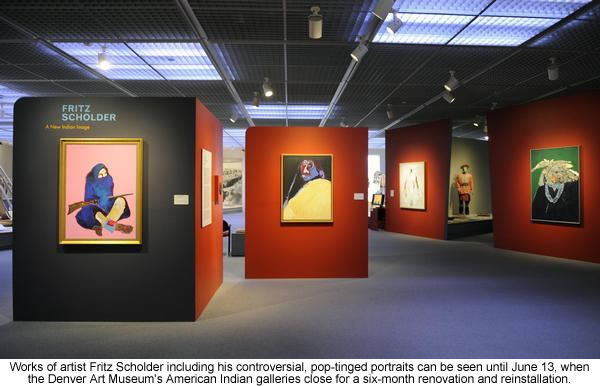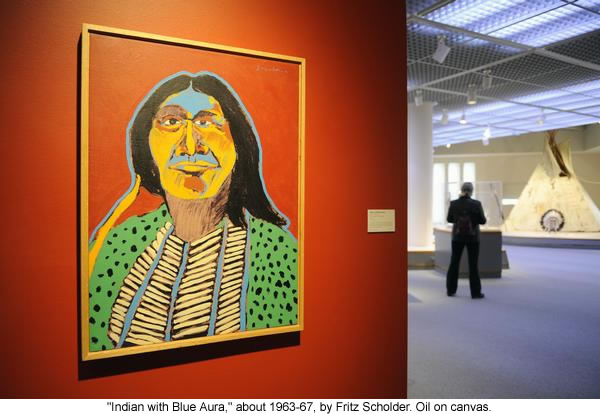 |
Canku Ota
|
 |
|
(Many Paths)
|
||
|
An Online Newsletter
Celebrating Native America
|
||
|
June 1, 2010 - Volume
8 Number 6
|
||
|
|
||
|
Denver Art Museum's
"Real" Indians Exhibit Nearing Closure
|
||
|
by Kyle MacMillan -
Denver (CO) Post Fine Arts Critic
|
||
|
credits: Photos by Diego
James Robles, The Denver Post
|
|
In 1967, while teaching at the Institute of American Indian Arts in Santa Fe, Fritz Scholder began a series of controversial, pop-tinged portraits that upended the way American Indians typically had been portrayed."I have painted the Indian real, not red," he wrote. The Scottsdale, Ariz., artist challenged the vision of the "noble savage" that outsiders sought to impose on Indians as well as the traditionalism that he believed choked Native American art from within. In so doing, Scholder (1937-2005) sparked a rethinking of what American Indian art could and should be and simultaneously pushed it toward the mainstream of contemporary art. Five paintings, five original prints and one bronze relief — including four works on loan from two area private collections — are on view in a small, rewarding exhibition in the Denver Art Museum's American Indian galleries.
This long-running but little- publicized show and the 700 or so other Indian objects in the permanent-collection galleries will go off view June 13, when the galleries close for a six-month renovation and reinstallation. The next several weeks are visitors' final opportunity to see the current selections before they are almost entirely replaced by another rotation of works from the museum's bountiful 18,000- piece collection. Since it began acquiring American Indian art in 1925, the museum has amassed one of the strongest and most comprehensive collections in the country — a distinction that, unfortunately, still seems to have gained little recognition among the Denver public. Though hardly comprehensive, the Scholder show nonetheless provides a telling overview of his principal artistic pursuits, including several fine examples of his portraits — long the core of his output. At times, the artist, who was one-quarter Luiseño, a California Mission tribe, delivered the expected pose, such as the smiling sitter in "Indian with Blue Aura" (About 1963-67).
But other times, he defied expectations, setting aside notions of idealization. A prototypical example can be seen in "Mean Indian No. 5" (1977), a compelling if unflattering portrait of a glowering figure with dark, intense colors. "But the positive does not exist without the negative, and the role of the artist is not to compromise, but to express the truth as he sees it with all the power of which he is capable," Scholder wrote. Breaking taboos, he was also not afraid to engage long-held stereotypes, such as the drunken Indian, portraying his subject with a can of Coors beer in "Indian at the Bar" (1970), a four- color lithograph. It is part of his famous "Indians Forever" suite, which he created in 1970 at the now-celebrated Tamarind Institute, a then-budding printmaking center that had moved that year to Albuquerque and become affiliated with the University of New Mexico. Scholder proved to be a master printmaker, excelling in monoprints and intaglio techniques in addition to lithography, and his works in that medium are an integral part of his output. Born in Breckenridge, Minn., into a family that moved frequently, Scholder took art lessons in South Dakota under the celebrated Oscar Howe, who was one of the first Indian painters who dared to break with closely held artistic conventions. Later in California, he studied two years at Sacramento State College with Wayne Thiebaud, who is associated with the pop movement because of his frequent focus on everyday objects, especially cakes, pies and other pastries. Thiebaud's influence runs through Scholder's work, especially Thiebaud's penchant for soft, luminous colors and luxuriant applications of paint, both of which can be seen in Scholder's "Seated Indian with Rifle (After Remington)" (about 1976). Scholder drew on many other sources of inspiration as well, including other painters in the Bay Area school, especially Richard Diebenkorn and English avant-garde painter Francis Bacon, whom he discovered on a trip to Europe in 1969. But no matter how evident the influences of other artists might have been, Scholder's work was always distinctively his own. Though he played a pivotal role in shaping how Indians are portrayed, he was, first and forement, a powerful, innovative artist who transcended his subject matter.
"FRITZ
SCHOLDER: A NEW INDIAN IMAGE." |
|
|
||
|
|
||
| Canku Ota is a free Newsletter celebrating Native America, its traditions and accomplishments . We do not provide subscriber or visitor names to anyone. Some articles presented in Canku Ota may contain copyright material. We have received appropriate permissions for republishing any articles. Material appearing here is distributed without profit or monetary gain to those who have expressed an interest. This is in accordance with Title 17 U.S.C. Section 107. | ||
|
Canku Ota is a copyright ©
2000, 2001, 2002, 2003, 2004, 2005, 2006, 2007, 2008, 2009, 2010
of Vicki Barry and Paul Barry.
|
||
 |
 |
|
|
The "Canku
Ota - A Newsletter Celebrating Native America" web site and
its design is the
|
||
|
Copyright ©
1999, 2000, 2001, 2002, 2003, 2004, 2005,
2006, 2007, 2008, 2009, 2010
of Paul C. Barry.
|
||
|
All Rights Reserved.
|
||

